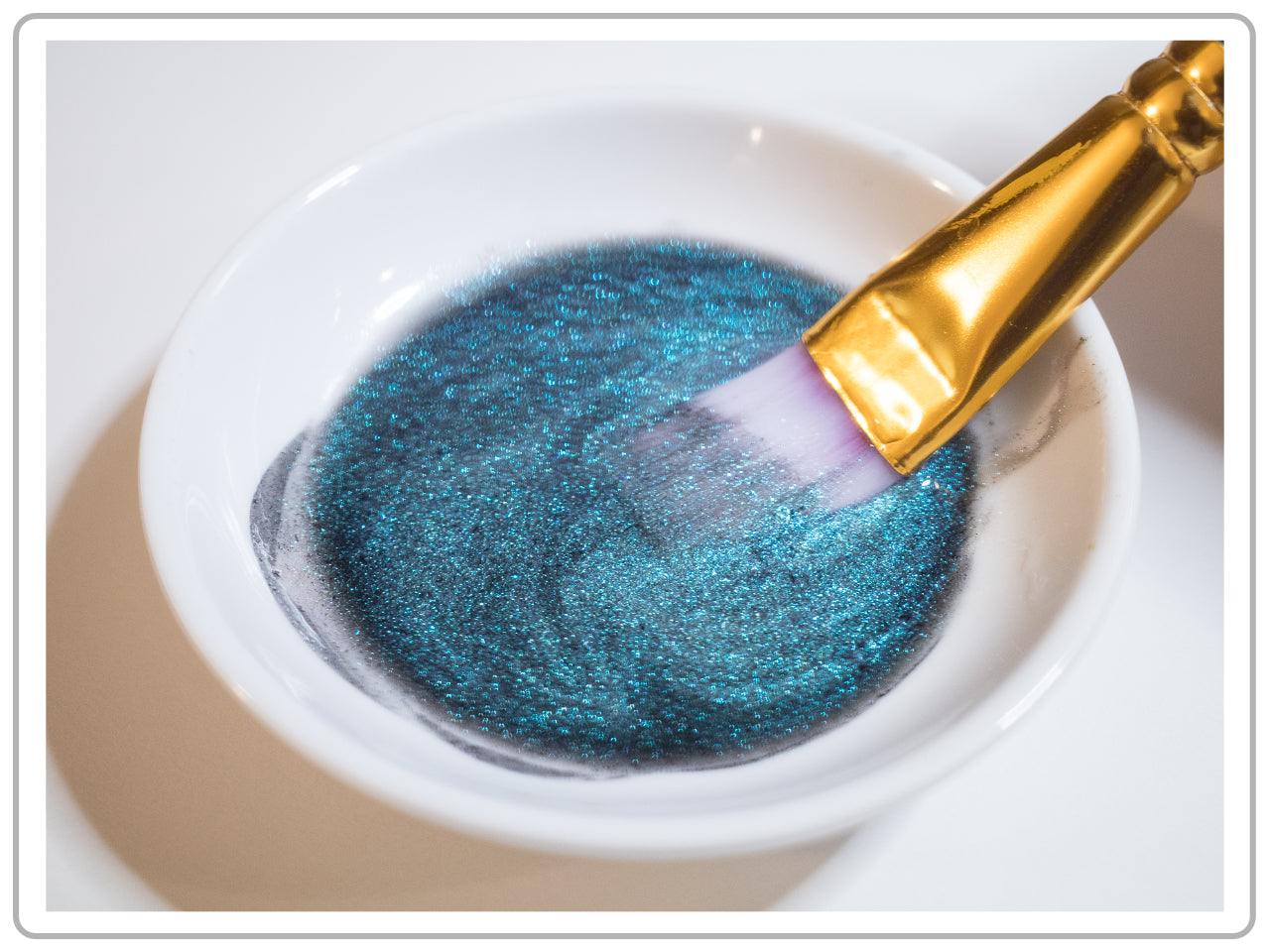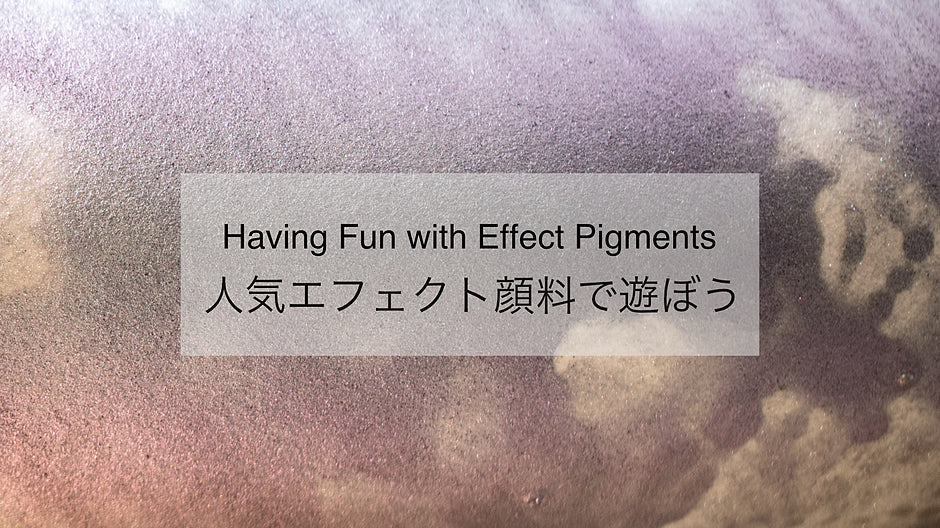Update: November 26th, 2024
Have you ever used effect pigments which show a variety of colors depending on the viewing angle and the base colors?
PIGMENT TOKYO carries a wide variety of effect pigments that are available in both our physical and online stores.
In this article, I decided to pick up a few effect pigments that were the best sellers I will also introduce some different ways to achieve polarized effects with them.
The following three pigments were the most popular colors throughout the year at PIGMENT TOKYO.
-

[Mi] Pacific Twinkle 5402
View products -

[Co] Arctic Fire T20-02
View prod -

[Xi] Micro Silver T61-10
View products
[Mi] series, which appears in different colors depending on if it’s painted on a white or black background; [Co] series is known for creating iridescent sheen; [Xi] series has high luminousness, all of them have their own unique characteristics and color effects.
First of all, let's start with the basic usage of effect pigments.
This time I am using Gum Arabic, a medium that is commonly used for making transparent watercolor, which I also recommend for those who are trying to make paint for the first time since it is more beginner-friendly.
Transparent watercolor is pretty self-explanatory, it is a type of water-based paint that contains high transparency.
Even if the paint dries out on the palette, it can be used again by applying some water to the paint, therefore, transparent watercolor is really easy-to-use even for kids.
However, some effect pigments have high surface tension and are very difficult to mix with mediums. In such cases, I recommend adding some Pigment Dispersant for Aqueous Paint to the mixture while making the paints, to blend the pigments with the mediums more easily.
(Pigment Dispersant for Aqueous Paint can be used for any type of pigment with light specific gravity.)
The following pictures show how I mixed [Mi] Pacific Twinkle 5402 in the ceramic palette plate by adding a small amount of water and a pigment dispersant to create a paste-like paint.
Effect pigments are very light and tend to float in the air, therefore, it is better to wear a mask to avoid inhaling the color dust if you are using a large amount of the pigments.

Using a dropper makes it easier to control the amount of water to add to the mixture.

If the pigments float on water and are difficult to mix, try adding a few drops of dispersant into it.
Then add medium at a ratio of about 1:1 to the pigment paste.
However, the ratio will vary for other water-based mediums such as acrylic and tempera, therefore, you can always adjust the amount of medium to your preference.
And customizability is one of the advantages of handmade paints.
If you make a lot of paints with gum arabic, you can also add some glycerin or honey to make the paints glossier and smoother.

Adding gum arabic medium to create watercolor paint.

Make sure to blend the medium and pigment well to avoid lumps in the paint.
And ta-daa! Here is the watercolor paint I made!

Next, let me show you a little trick that can give a special touch to the paint.
What we need is a black pigment paste.
This item does not contain any binder or adhesive, just a mixture of water and pigment, so you can make paint easily by adding a water-based medium to it.
Effect pigments change the appearance of color depending on whether the underlying color is black or white, however, you can create a similar effect by adding colors to it.
For example, let's put a few drops of black pigment paste in the paint I just made.
And here is how it looks when mixed.
It is fun to watch how the pigment slowly changes its color and the marbling effect.
I added two to three drops of black pigment paste to it.
Tips: Mixing too much pigment paste will weaken the adhesive strength of the paint, therefore, remember to increase the amount of medium along with the pigment paste.

Look how beautiful the marbling effect is while mixing the paint.

Mix the paint well with a brush before painting.
These are comparisons of the paints on paper. The color on the left is before mixing the black paste, while the black paste is completely blended with the paint on the right.
Mixing just a little bit of black into seemingly just white glitter paint creates such change and brings out the brilliant color.
When using a substrate that cannot be painted black, adding dark paint is another possible way to bring out the characteristic of effect pigments.
 【Art Materials Used】
【Art Materials Used】
Color material: [Mi] Pacific Twinkle 5402 (PIGMENT TOKYO Original)
Pigment Paste Carbon Black (Holbein Art Materials)
Medium: Gum Arabic Medium (KUSAKABE)
Substrate: Bamboo Washi for Watercolor (Awagami Factory)
Let's try some of the other popular colors I mentioned earlier.
I added the black pigment paste to [Co] Arctic Fire T20-02, then mixed it with the same watercolor medium, and then spread it onto the paper palette. On top of that, I applied a layer of [Mi] Pacific Twinkle 5402, and lastly, I covered the paint with a piece of Bamboo Washi Paper.

As you can see, the colors are randomly traced and created the pattern on the paper.

【Art Materials Used】
Color material: [Co] Arctic Fire T20-02
[Mi] Pacific Twinkle 5402 (PIGMENT TOKYO Original)
Pigment Paste Carbon Black (Holbein Art Materials)
Medium: Gum Arabic Medium (KUSAKABE)
Substrate: Bamboo Washi for Watercolor (Awagami Factory)
Lastly, let's have another experiment with [Xi] T61-10 Micro Silver.
I added the black pigment paste to Micro Silver as well.
Unlike the other two effect pigments, it has higher surface tension and the particle is more inseparable, so I used a palette knife to mix the pigments thoroughly.

It looked magical when I was mixing it on the paper palette.
Again, I applied the paint in different ways to show you the following results.
As the base colors, I painted [Xi] T61-10 Micro Silver alone on the left samples and I added black paste mixed with acrylic emulsion to it on the right samples. I coated Pacific Twinkle 5402 over the top on both samples.
The top samples are applied Pacific Twinkle 5402 only, but black is added to it on the bottom colors.
As you can see, if you add more layers of effect pigments, you can create different kinds of polarizing effects.

【Art Materials Used】
Color material: [Co] Arctic Fire T20-02
[Mi] Pacific Twinkle 5402 (PIGMENT TOKYO Original)
Pigment Paste Carbon Black (Holbein Art Materials)
Medium: Gum Arabic Medium (KUSAKABE)
Acrylic Emulsion
Substrate: Bamboo Washi for Watercolor (Awagami Factory)
Effect pigments can be used in various ways: coloring as they are, mixing with black pigment paste, coating with other effect pigments underneath or overlaying with a black base color.
It would also be interesting to transfer a marbling pattern by capturing a moment in the process of Suminagashi too.
Please experience the unique effect of effect pigments.
Translated by Atsumi Okano, Nelson Hor Ee Herng
PIGMENT TOKYO Art Materials Experts





